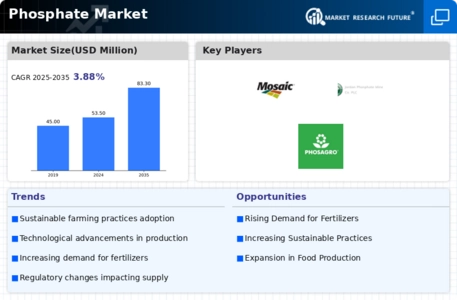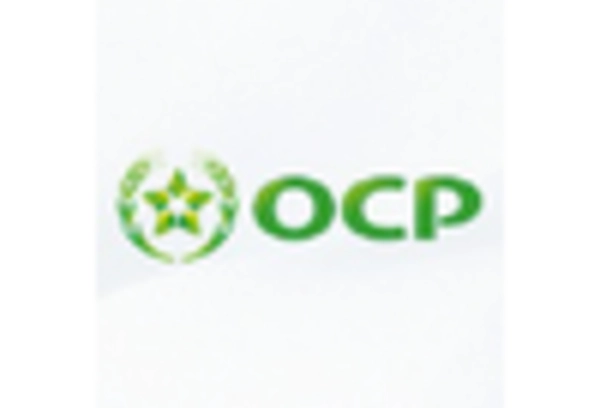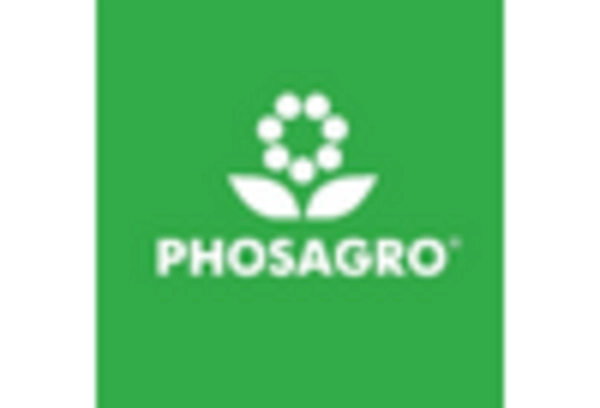Rising Demand for Fertilizers
The increasing The Phosphate Industry. Fertilizers, particularly those containing phosphates, are essential for enhancing crop yields. In 2023, the demand for phosphate fertilizers reached approximately 45 million metric tons, reflecting a steady growth trend. This demand is expected to continue as agricultural practices evolve to meet the needs of a growing population. The Phosphate Market is thus positioned to benefit from this trend, as farmers seek to optimize their production through the use of phosphate-based fertilizers. Furthermore, the shift towards sustainable agriculture practices may also bolster the demand for phosphate fertilizers, as they are integral to maintaining soil health and fertility.
Increasing Awareness of Soil Health
There is a growing awareness of the importance of soil health in agriculture, which is positively influencing the Phosphate Market. Farmers and agricultural stakeholders are recognizing that healthy soils are vital for sustainable crop production. In 2023, educational initiatives and research highlighted the role of phosphates in maintaining soil fertility and structure. This awareness is driving demand for phosphate fertilizers, as they are essential for replenishing nutrient-depleted soils. Moreover, the emphasis on regenerative agriculture practices is likely to further boost the Phosphate Market, as these practices often incorporate phosphate-based fertilizers to enhance soil health and productivity.
Geopolitical Factors Affecting Supply Chains
Geopolitical factors play a crucial role in shaping the Phosphate Market. Trade policies, tariffs, and international relations can significantly impact the supply chains of phosphate producers. For instance, in 2023, tensions in key phosphate-producing regions led to fluctuations in supply, affecting prices and availability. Countries that rely heavily on phosphate imports are particularly vulnerable to these geopolitical dynamics. As a result, there is a growing trend towards diversifying supply sources and investing in domestic production capabilities. This strategic shift may enhance the resilience of the Phosphate Market against geopolitical uncertainties, ensuring a more stable supply of phosphates for agricultural use.
Technological Innovations in Phosphate Extraction
Technological advancements in phosphate extraction and processing are reshaping the Phosphate Market. Innovations such as improved mining techniques and enhanced processing methods are leading to more efficient extraction of phosphates. For instance, the introduction of advanced flotation technologies has increased recovery rates, thereby reducing waste and improving overall productivity. In 2023, the efficiency of phosphate extraction processes improved by nearly 15%, which has significant implications for production costs and environmental impact. As these technologies continue to evolve, they are likely to attract investment and drive growth within the Phosphate Market, enabling producers to meet the rising demand for phosphate fertilizers more sustainably.
Environmental Regulations and Sustainability Initiatives
The Phosphate Market is increasingly influenced by environmental regulations and sustainability initiatives. Governments and organizations are implementing stricter regulations on phosphate mining and fertilizer application to mitigate environmental impacts, such as water pollution and soil degradation. In 2023, several countries introduced policies aimed at reducing phosphate runoff, which has prompted producers to adopt more sustainable practices. This shift not only aligns with The Phosphate Market opportunities for eco-friendly phosphate products. As the industry adapts to these regulations, it may lead to innovations in sustainable phosphate production methods, further shaping the landscape of the Phosphate Market.


















Leave a Comment